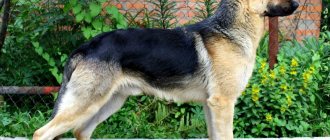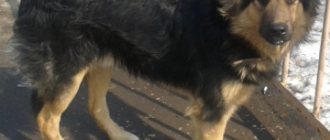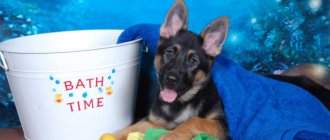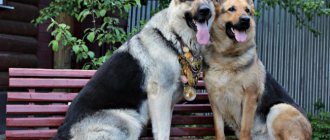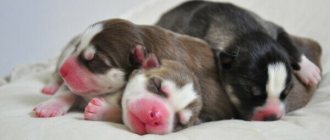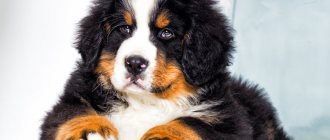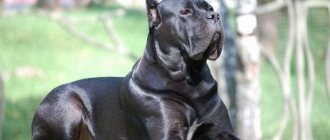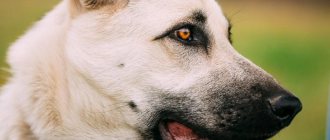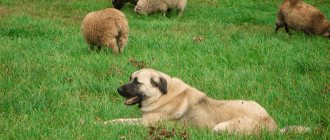East European Shepherd puppies are especially popular among dog breeders. This is due to the fact that the dog has a considerable number of positive qualities. She is very kind, smart and easy to train. Before getting such an Eastern European dog, you need to familiarize yourself with the main features of shepherd puppies.
East European Shepherds are dogs that are often kept at home.
When do the eyes open and how much do they weigh?
Immediately after birth, such dogs do not hear or see anything. Among their sense organs, only their sense of smell is well developed. It is with his help that they find their mother in the first days of life. Within two weeks, the puppies' eyes open and they begin to see the world around them.
After birth, all Shepherd puppies are very similar to each other.
They have a black, pointed muzzle with a large nose and short fur. On average, newborn dogs weigh 300-500 g. Additional information. The more dogs in the litter, the less the VEO puppies weigh.
What to feed the young "Eastern"
It's no secret that proper nutrition helps dogs avoid many diseases.
The basis of food for shepherd dogs is fresh meat (chicken, beef) and cottage cheese. Meat can be easily replaced with boiled fish.
Also, the puppy’s diet should include chicken eggs, vegetables, soups, cereals, and special vitamin supplements. You should not give your young shepherd food too thick or hot. It is highly undesirable to overfeed your pet.
For an adult dog, store-bought food may be suitable.
Development by day in the first month
Many dog breeders are interested in how puppies develop in the first 30 days after birth. Features of a dog's development in the first month of life are presented in the table below.
| Days | Changes |
| 1-10 | Pain sensitivity gradually decreases. Body weight doubles. |
| 11-15 | The eyes begin to open, and a reflex chill appears. |
| 16-20 | A fat layer is formed and hearing improves. |
| 21-25 | The puppy learns to bite and chew solid food. His sucking reflex disappears. |
| 26-30 | Motor activity increases. East European Shepherd puppies begin to respond to their name. |
What does an East European Shepherd look like?
Externally, the East European Shepherd is similar to the German one. Ordinary people practically cannot distinguish them from each other. The breed belongs to the medium-large category. Males at the withers reach 66-76 cm, and females - 62-72 cm. Weight depends on the health of the dog, its gender and age. The body weight of males can be in the range of 35-60 kg, and that of females - 30-50 kg. Some members of the breed may weigh significantly more due to a tendency towards obesity.
How is it different from German?
Although outwardly these two beautiful breeds have many similar features, there are still differences between them. Representatives of the Eastern European line have larger sizes, fewer color options, thicker coats, a different back line and type of movement. VEO also differs in its mental properties. The German Shepherd's temperament is fiery, while the Eastern European's is reasonable and calm. Other characteristic differences:
- Wool. The German has a more elegant covering coat. It is longer, especially on the hind limbs.
- Addition. The Eastern European has less pronounced limb angles, a higher neck projection, a short tail and a steeper pastern.
- Movements. The creeping trot of the German Shepherd is not typical of the Eastern European.
- Wool color. A German Shepherd's paws can be any red shade, and a pronounced one. Eastern European - the owner of a light fawn, gray or almost white tan color.
Development up to 12 months
You can see the development of shepherd puppies up to one year in the table:
| Month | Changes |
| 1-3 | At this age, dogs begin to see and develop hearing. They learn to move independently and chew solid food. Pets are actively increasing their body weight. |
| 4-5 | The formation of the immune system begins. The puppy moves more. |
| 6 | At this age, the East European Shepherd begins to develop its character. The dog exhibits various behavioral reactions. |
| 7 | Puberty begins. In females, eggs are formed. The first heat appears. |
| 8-12 | Males reach puberty. |
Additional Information. Active growth in shepherd dogs continues until 7-8 months. After this, their muscle mass is formed and their body volume increases.
Features of care
You need to regularly take your puppy for walks in the fresh air.
Every person who is going to purchase such a purebred pet from a nursery must figure out how to properly care for it.
First walks
The puppy must be taken outside for walks regularly. This is done not only so that he can run around in the fresh air, but also to teach the dog to relieve himself outside the apartment. At an early age, puppies cannot tolerate and often go to the toilet in the house. To wean your dog off of this, you will have to take him outside every day and walk with him until he has done all his “things.”
In the first six months, when taking your pet for a walk, you should not allow him to climb the stairs on his own. The dog's back is still too weak and cannot be strained.
Feeding in the first three months
In the first weeks after birth, doggies feed only on mother's milk. After this, complementary foods are gradually added to the diet:
- Dry food. Dry food is often used as complementary food. Before use, it must be soaked in water.
- Meat. Puppies should be given lean meat products. Turkey, rabbit or beef will do.
- Dairy products. You need to gradually add yogurt, kefir or cottage cheese to your dog’s diet.
Important! For complementary feeding, you cannot use baby formula, cow's milk and fatty meat.
Meat is the basis of a dog’s diet
When the puppy is one and a half months old, you can add to the diet:
- oat and rice porridges;
- boiled beef meat;
- raw eggs;
- milk.
How to feed
Before getting East European Shepherd puppies, you need to familiarize yourself with the peculiarities of their feeding. It is important to develop a meal schedule for your pet in advance. The number of feedings largely depends on the age of the animal:
- 2 months – 6 times;
- 3 months – 5 times;
- 6 months – 3 times;
- from one year and older – 2 times.
The daily food intake for a pet under one year of age should consist of 60% boiled or raw meat. You should also add to your diet:
- buckwheat;
- fruits;
- vegetables;
- greenery;
- offal.
Vaccinations
To maintain good health in puppies, you will have to vaccinate them. All vaccinations must be completed until the dog is six months old. At the age of 8-10 weeks, vaccinations are carried out against diseases such as:
- plague;
- infectious hepatitis;
- leptospirosis;
- enteritis;
- parainfluenza
During vaccination, you should adhere to the following tips:
- two weeks before vaccination, deworming is mandatory;
- You cannot vaccinate a pregnant dog;
- the puppy being vaccinated must be completely healthy.
Note! The rabies vaccine is given when the dog is 12-13 weeks old.
Bathing
Bathing is a procedure that needs to be carried out regularly.
Shepherd dogs have quite beautiful fur with various variations of tan, and therefore it must be properly cared for. To keep the coat beautiful, the puppy needs to be bathed regularly.
It is necessary to bathe your dog after he is three months old. It is necessary to accustom your pet to water procedures in a playful way. When washing, you need to use a special shampoo for dogs. You need to wash your dog with your hands or a soft brush. After completing the procedure, the pet must be thoroughly dried with a towel.
Teeth cleaning
By 2 months from birth, puppies already have 28 baby teeth. When the dog turns three months old, they begin to change to native ones. As a result, an adult shepherd should have 42 teeth.
First, the puppy's incisors fall out. At four months of age, the fangs change. To speed up the process of baby teeth falling out, you need to give your dog something hard to chew on. This could be a bone or, for example, a rubber ball. During the change of teeth, dogs may develop a rise in body temperature, and this is often accompanied by general malaise.
Additional Information. Even though baby teeth will fall out over time, they still need to be cared for. They need to be brushed daily with a special toothpaste for dogs.
Training
Shepherd training should be done from an early age.
Before you get an elite VEO puppy, you need to familiarize yourself with the features of its training. When training your dog, you must do the following:
- Accustom your pet to its name. Everything must be done to ensure that he responds to his name.
- Wean the dog from any manifestations of aggression. The dog should not be allowed to growl at its owner or strangers. This action needs to be stopped from an early age.
- Teach basic commands. It is necessary to ensure that the shepherd grows up obedient. To do this, she must be taught such commands as “fu”, “no”, “place”.
How to toilet train
A dog should only go to the toilet outside.
Every dog breeder must figure out how to properly toilet train a dog. The owner needs to constantly be near the puppy and watch for signals that indicate that he wants to go to the toilet. These signals include active behavior of the dog. She may run quickly around the room, spin around, or whine near the door. In such cases, you must immediately take your pet outside so that he can go to the toilet.
When can you wean from your mother?
It is very important that the owner separates the puppies from their mother in time. This should be done no later than two months. It is at this time that dogs’ psyche and thinking are formed. Animals begin to socialize and interact with people.
Important! If the female does not have enough milk, and there are other problems with lactation, you can try to wean the dogs earlier.
VEO standard
Before buying a pet, you should study the breed standard in order to purchase a purebred representative. This is especially true for those who plan to participate in exhibitions and competitions. It is recommended to contact a kennel club, because German Shepherd puppies are very similar to Eastern European ones. The standard describes the following characteristics of the breed:
- The head is large, has the shape of a regular wedge, and is proportional in overall dimensions. The frontal part is wide, rounded, smoothly blending into the muzzle. The cheekbones are muscular and rounded. When viewed from the side, the bridge of the nose is parallel to the extended line of the forehead.
- The lips are dry and thick, fitting tightly to the muzzle and not drooping.
- The teeth are straight, white, and tightly set. According to the standard, only a complete set of incisors and canines is allowed - 42 teeth. Bite without gap, scissor bite.
- The nose and eyes are set slantingly and have an oval shape. The eyelids are dry, dense, completely covering the whites. The outer corner is raised towards the ear.
- The ears are medium, triangular in shape, only erect ears are allowed. Set wide apart, can't be too big.
- The limbs are muscular, proportional, and sinewy in the lower part. The front legs are parallel with the elbows pressed to the chest. The hips are noticeably elongated, the back is strong.
- The tail is saber-shaped, reaching to the hocks or below. In its natural state it trots low or between its hind legs. When working, it rises to the spine or higher.
Breed defects
In dog behavior, cowardice, lethargy, unbridled aggression and indifference are considered vices. Minor faults are shortcomings in the external characteristics of the animal. More pronounced deviations, due to which the East European Shepherd loses its working qualities, are considered disqualifying defects:
- weak ligamentous apparatus;
- loose, rough or light constitution;
- weak muscles;
- light eye color;
- brown or red tan on saddle coat;
- curvature of the limbs;
- weakness or deformation of the ears;
- corkscrew tail;
- unbalanced movements;
- lack of teeth.
- Who is entitled to a pension supplement for children born before 1990?
- Korean cucumber salad for the winter - step-by-step recipes for preparing it at home
- Why will the monthly funded pension decrease?
Choosing a puppy: features for different types of breed
Powerful paws are one of the features of this breed.
It is necessary to buy a VEO puppy in specialized nurseries, since their owners are responsible for the health of their pets. When choosing a classic European Shepherd, you need to make sure that it meets the breed standard. Main characteristics:
- shiny and smooth coat;
- lack of fringe around the ears;
- straight tail;
- strong and straight limbs;
- straight ears, no discharge or unpleasant odor.
When choosing a dog of the Czech or Slovak line, you need to pay special attention to the limbs. The paws should be straight and strong. There is also an American line of Shepherds. When choosing such dogs, you need to pay attention to their behavior, since many of them have an unstable temperament.
On a note! In nurseries in Moscow. region VEO puppies cost 25-40 thousand rubles.
East European Shepherds are popular pets among dog breeders. Before you get such dogs, you need to familiarize yourself with their description, as well as the features of caring for them.
History of the origin of the East European Shepherd
With the coming to power of the Bolsheviks in the 20s of the last century, an urgent need for service dogs arose. German shepherds were not universal, as they could not work throughout the entire territory of the USSR. In Siberia, Karelia and Kamchatka, animals froze to death or had to be warmed up every 4 hours. In 1924, the Krasnaya Zvezda nursery was created, which was engaged in breeding the domestic VEO breed. The task of Soviet dog handlers was to obtain a universal dog with the following characteristics:
- large;
- controlled;
- hardy;
- which could work in any climate.
A large number of German Shepherds were included in the selection, but Central Asian, Laika and other breeds were added to them. The founder of the line was the dog Abrek, who starred in the film Gaichi in 1938. The primary standard was formed in 1964. It was approved by the Canine Council of the USSR Ministry of Agriculture. In modern times, the breed remains popular in the territory of the former Soviet Union, but the number of purebred individuals is steadily falling.
FCI breed recognition
If we talk about world opinion, the Eastern European breed is still not recognized by the FCI - Federation Cynologique Internationale. Its experts remain loyal to the German line. Only the following cynological organizations recognized the breed:
- UCI – International Union of Kennel Clubs;
- MKC – International Kennel Union.
